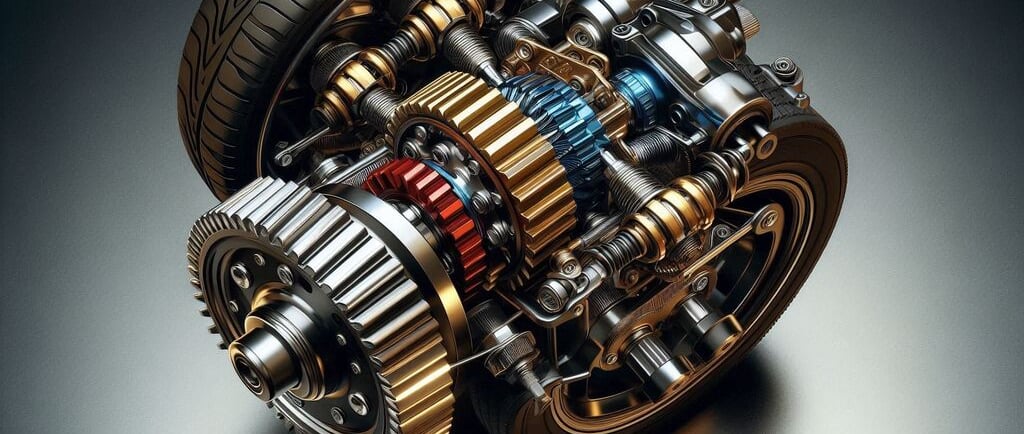Differential: Allows wheels to rotate at different speeds, aiding in cornering.
If you’ve ever driven a car, you’ve probably experienced how smoothly it navigates tight turns or corners.
TRANSMISSION COMPONENTS
11/12/20244 min read


Understanding the Differential: A Crucial Component for Smooth Cornering
If you’ve ever driven a car, you’ve probably experienced how smoothly it navigates tight turns or corners. But have you ever wondered what makes this possible? The answer lies in a small yet vital component of your vehicle known as the differential. This mechanical device allows your wheels to rotate at different speeds, which is especially useful when cornering. But how does it work, and why is it so important?
In this article, we’ll explore the role of the differential, its importance in vehicle performance, and how it helps in providing a smooth and controlled driving experience.
What is a Differential?
A differential is a gear system that splits the engine torque (rotational force) between the two wheels on an axle, allowing them to rotate at different speeds. While this may seem like a minor function, it's crucial for smooth driving, especially during turns. Without a differential, the wheels would be forced to rotate at the same speed, which would result in uncomfortable driving, especially on curves or corners.
Why Do Wheels Need to Rotate at Different Speeds?
When a vehicle turns, the wheels on the inside of the turn cover a shorter distance than the wheels on the outside. If the inside and outside wheels were forced to rotate at the same speed, the vehicle would experience excessive tire wear, poor handling, and even skidding.
The differential ensures that the wheels can rotate at different speeds to accommodate this difference in distance, allowing the vehicle to make turns smoothly and safely.
Types of Differentials
Differentials come in various forms, each suited for different driving conditions and vehicle types. Here are the most common types:
1. Open Differential
The most common type, the open differential, allows the left and right wheels to rotate at different speeds under normal driving conditions. However, it has limitations when one wheel loses traction, as power is sent to the wheel with less grip.
2. Limited Slip Differential (LSD)
A limited-slip differential improves upon the open differential by reducing the power sent to the wheel that slips and redirecting it to the wheel with more grip. This helps improve traction, particularly in slippery conditions like rain or snow.
3. Locking Differential
A locking differential can lock the two wheels on the same axle, forcing them to rotate at the same speed. This is useful in off-road situations or when maximum traction is needed, such as in 4WD vehicles.
4. Torque-Vectoring Differential
The torque-vectoring differential is a more advanced system that actively adjusts the amount of torque sent to each wheel. It’s often found in high-performance vehicles, offering superior handling and stability during aggressive cornering or in adverse driving conditions.
The Role of the Differential in Cornering
The primary role of a differential in cornering is to allow the wheels to rotate at different speeds while turning. This is critical because when a vehicle turns, the inner wheels travel a shorter distance than the outer wheels. Without a differential, both wheels would rotate at the same speed, which would cause significant stress on the tires and suspension, leading to poor performance and handling.
The differential solves this issue by enabling the inner wheel to rotate more slowly while the outer wheel rotates faster, ensuring that the vehicle corners smoothly without skipping or dragging.
Benefits of a Differential in Cornering:
Improved Handling: A differential provides better control while turning by allowing each wheel to move independently, improving overall handling and responsiveness.
Reduced Tire Wear: By allowing the wheels to rotate at different speeds, a differential minimizes unnecessary wear on the tires, especially during sharp turns.
Better Traction: In systems like the limited-slip differential, traction is improved during turns, helping to prevent wheel spin and maintain control on slippery or uneven surfaces.
How Does the Differential Affect Vehicle Performance?
The differential plays a crucial role in optimizing vehicle performance in a variety of conditions. Its impact on handling, traction, and overall driving dynamics cannot be overstated. Here's how the differential affects your driving experience:
1. Handling and Maneuverability
A vehicle’s ability to handle tight turns and navigate curves depends heavily on the differential. By allowing the wheels to rotate at different speeds, the differential helps maintain stability and smooth cornering. This is particularly important in sports cars or performance vehicles, where precise control is essential.
2. Fuel Efficiency
A well-functioning differential can contribute to better fuel efficiency by ensuring that the vehicle’s energy is distributed efficiently between the wheels. When the differential is in good condition, it reduces unnecessary friction and wear, which helps optimize fuel consumption.
3. Off-Road Capability
In off-road vehicles, the differential plays an even more crucial role. Differentials like locking or torque-vectoring systems help distribute power to the wheels with the most traction, allowing the vehicle to navigate rough terrains like mud, rocks, or sand more effectively.
Conclusion: Why the Differential is Essential for Your Vehicle
The differential is a critical component that plays a vital role in the way your vehicle handles and drives. By allowing the wheels to rotate at different speeds, it ensures smooth cornering, improved traction, and better overall performance. Whether you're navigating tight city corners, cruising on highways, or tackling off-road challenges, the differential is always working behind the scenes to provide you with a safer and more comfortable driving experience.
If you're looking to enhance your vehicle’s performance, understanding how the differential works and ensuring it's properly maintained is key. Want to dive deeper into how other car components work? Check out our related articles on vehicle maintenance tips and vehicle performance optimization.



